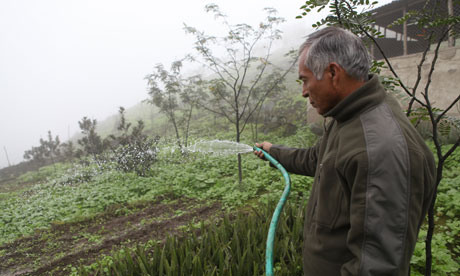An initiative to collect moisture from the thick sea mist around Lima represents an inventive, cost-effective solution to the ever-expanding Peruvian capital's shortage of water

Artemio Alfaro uses water produced by the fog nets on his aloe vera plants. Water is scarce for people on the outskirts of Peru's capital, Lima. Photograph: Dan Collyns
Sandwiched between the cool ocean currents of the Pacific Ocean and the Andean foothills, Peru's coastal capital is a meteorological anomaly. Lima is the second-largest desert city after Cairo, yet it has a cooler and more humid climate than its subtropical latitude might suggest. Rainfall is extremely low – less than 4cm annually – but humidity can reach 98%.
The city – home to a third of Peruvians, nearly 9 million people – is dependent on three rivers that flow from the Andes, the Rimac, Chillon and Lurin. But as the city continues to expand outwards, up to 150,000 migrants a year swell its peripheries, where there is little or no infrastructure. For these people, water is a scarce resource.
Some newcomers are now turning to the climatic phenomenon known locally as the "donkey's belly" – the thick, white sea fog that blankets coastal parts of the city for up to nine months of the year – as a source of water. On hills in Villa María del Triunfo, a sprawling shantytown in the city's south, strange rectangular structures loom out of the fog like ghostly sentinels. Closer inspection reveals they are four-by-six-metre bamboo and metal frames draped with a thick mesh. Slung underneath them run plastic gutters – water drains down pipes, through a biofilter, and into 1,100-litre tanks.
"The water is crystalline," enthuses Abel Cruz, founder of the Peruvians Without Water movement, scooping a handful from one of the tanks and letting it run through his fingers. While it is not yet potable, the water is used for farming, cleaning, washing clothes and dishes, and even cooking.
Over the past five years, his organisation – helped by foreign co-operation – has built 32 fog nets in the district. Beginning with 10 nets in the Bellavista settlement in 2009, Cruz secured a $20,000 grant from the US development agency USAid to build 22 more nets in the nearby Los Tunales de Asall community, supplying around 75 families with water. Each net, complete with a tank, costs less than $800 to construct.
"We were able to fund a project that takes Lima's 98% humidity and helps turn it into an opportunity to obtain clean water, often a challenge to some excluded populations living in the city outskirts," said a spokesman for USAid-Peru.
Being able to count on a daily supply of 50-150 litres of water has been a lifeline for 66-year-old Artemio Alfaro and his family. He uses it to irrigate aloe vera (sábila) plantations. He sells the plants, at six Peruvian soles ($2.30) each, to three Peruvian health-product firms. He aims to get organic certification, which would double the price for the plants.
"The fog nets mean we have practically no water costs in the winter months, it's a saving of around 60% in our cost of living," said Alfaro. Using the water collected from the fog nets, he also grows potatoes, radishes, squash, beetroot and lettuce, feeding his family as well as supplying their small restaurant, where his neighbours can lunch on duck, rice and roasted cuy (guinea pig).
"The poor pay more for water than the rich," says Cruz. "They pay 10 to 12 times more for water of doubtful origin." Those who live in neighbourhoods where there are no water mains rely on water brought in cistern trucks, paying around 3.5 soles for a 200-litre barrel.
"We have one of the lowest water tariffs in Latin America," says Rossina Manche, general manager of Lima's waterboard, Sedapal. "It's very clear to us that the cost of water should go up so that we can get 100% coverage but, as a poor society, we're not ready to pay the real cost."
Manche says 92% of Lima residents were connected to the water mains in 2012, but connecting those living on the city's hilly outskirts could cost up to six times more. "Our commitment is to give 100% coverage by 2016, but that can only happen with a big investment of 5bn soles," she adds.
Both a special report on emissions scenarios by the Intergovernmental Panel on Climate Change (pdf) and the Stern report identify Peru as one of the countries that will be most affected by climate change.
More than 70% of the world's tropical glaciers are in Peru, and they are melting at an accelerated rate. The three rivers supplying Lima are filled with glacial melt-water that will eventually disappear. A series of infrastructure projects, including a trans-Andean tunnel and the reinforcement of glacial lakes, are planned over the next 30 years, says Manche. She predicts these measures will protect Lima from "water stress" for that period.
Meanwhile, Cruz has his own goals. He wants coastal communities to take advantage of the fine mist of water in which they live for much of the year, and is seeking international funding to build 200 fog nets along Peru's 3,000km coas












No comments:
Post a Comment